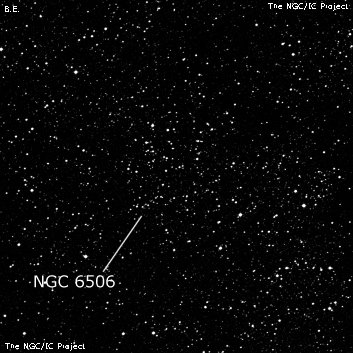
John Herschel discovered NGC 6506 = h3717 on 29 Jul 1834 and recorded "A very loose but rich cluster, which fills many fields. Stars small." This is a rich region of the Milky Way, though probably not a true cluster.
The position is given here is from Harold Corwin's NGC positions file and is 2' southeast of JH's position. Skiff & Luginbuhl recorded 30 stars 11-14 in a 7-8' area although JH's description refers to several fields. ESO (521-SC60) classifies this as a questionable cluster and RNGC as nonexistent.
400/500mm - 17.5" (8/3/97): at 100x appears as a weak, circular Milky Way enhancement of approximately two dozen mag 13-14.5 stars over an unresolved glow situated in a rich portion of the Milky Way. At 220x, this group is ~6' diameter, although it is not very well detached so the borders are somewhat arbitrary. As many as 50 stars are now visible as a number of mag 15 and fainter stars are resolved. Some unresolved background haze is still evident. Also noticed at 100x was Ru 136, a smaller circular glowing spot ~8' WSW of NGC 6506. At 220x, Ru 136 appeared ~2.5' diameter with about 10 extremely faint stars are resolved over the background glow. It is situated just NW of two mag 10-11 stars.
John Herschel's description for NGC 6506 probably applies to the entire low power Milky Way field and this object is listed as nonexistent in the RNGC.
17.5" (7/20/96): at 220x, the most noticeable grouping is a small cloud of roughly two dozen mag 13-15 stars in a 5' diameter over unresolved background haze. Situated in a fairly rich Milky Way field of mixed stars, so does not stand out.
Notes by Steve Gottlieb